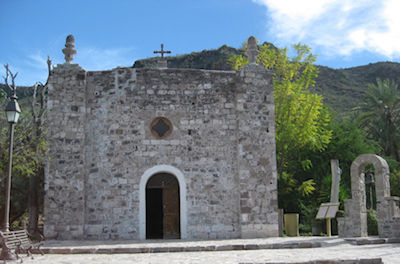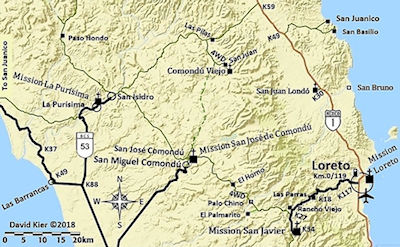 |  |
By David Kier
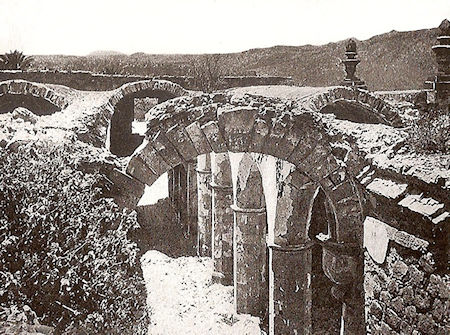
The fifth California mission was founded in 1708, by Padre Julián de Mayorga. The original mission location was twenty-two miles to the north. The mission moved in 1736, soon after Padre Mayorga’s death following his twenty-eight years of service at Comondú. Today, that original location is called Comondú Viejo. That site had an adobe church, built in 1716. It has vanished with just a stone-foundation outline, now overgrown with cactus. Some corral walls, irrigation works, and ruins of Padre Mayorga’s stone home remain. Read more.
In 1717, Mayorga had inherited a successful Jesuit farm in a well-watered canyon. This had been a visita of Mission Loreto, named San Ignacio. It was transferred to the Comondú mission. This visita site was more promising than the Comondú mission’s farm. It was likely that the move was already planned before Mayorga died, as he had been terribly ill. When the mission moved far south from Comondú, it did not change its name. Visita de San Ignacio ceased to exist when the moved mission replaced it.
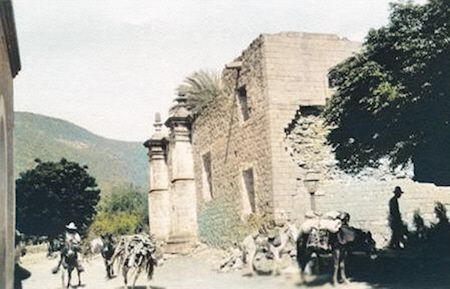
Just over two miles away, was another visita, belonging to Mission San Javier, named San Miguel. When Mission San José de Comondú moved, the Visita San Miguel was transferred to it, making it San Miguel de Comondú. One version of the story says Mission San José de Comondú moved to San Miguel for just one year before finalizing at its visita of San Ignacio. The San Miguel visita was called a mission by some people, possibly because Jesuits had been stationed there in past years while in preparation for future duties.
The new Jesuit in charge at the new Comondú location, for eight years, was Padre Franz Wagner. José Rondero was next, for six years. In 1751, Franz Inama came to Comondú. The mission prospered with its agriculture. Mission San José and its visita of San Miguel, de Comondú, also provided food for other missions. A new church that represented its value to the California mission program was in order.
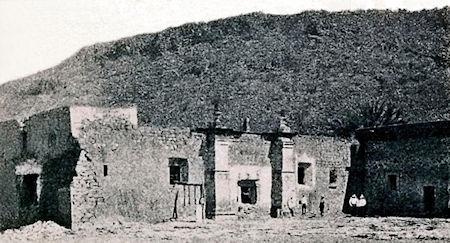 A massive 3-nave stone church was built between 1751 and 1761. It would be the largest mission church in all the Californias! Stone masons that completed their work on Mission San Javier, came to Comondú. Unfortunately, the Baja California missions were in decline with falling populations. The Jesuit expulsion began in 1767 after the Order had a falling out with the Royal Court of Madrid.
A massive 3-nave stone church was built between 1751 and 1761. It would be the largest mission church in all the Californias! Stone masons that completed their work on Mission San Javier, came to Comondú. Unfortunately, the Baja California missions were in decline with falling populations. The Jesuit expulsion began in 1767 after the Order had a falling out with the Royal Court of Madrid.
The Franciscans replaced the Jesuits after four months absence and then served for five years. Once they discovered the potentials in Alta California, following the 1769 Serra Expedition to San Diego Bay, the Franciscans happily turned over peninsula mission duties to the Dominicans.
These Dominicans were extremely ambitious, if not a bit surprised at the poor conditions they found. Yet, they continued building and advancing the missions as best they could. When the Franciscans abandoned the Baja California missions, they removed as much as they could to furnish their Alta California missions. This included altar ornaments, equipment, animals, and many Natives of the peninsula.

The Dominicans persevered and built the stone mission churches at San Ignacio, Santa Gertrudis, and San Borja. They were on the peninsula the longest (1773-1855) and eleven stayed on or arrived after the Mexican Revolution which ended Spanish rule. In a 1799 report, we see that this stone church was 30 x 13 varas or 82 feet x 36 feet (a vara or Spanish yard = 33 inches), making it the widest in the territory. It had an arched ceiling, and the interior was divided into three naves richly decorated. There were three altars, twenty-five paintings, and six images. The vestments were the finest. The spacious dwelling of the missionary was also built of stone and contained a library of one hundred twenty six volumes. This building would eventually become the chapel that since 1936 has been identified as the mission.
There have been plans made to show a reconstructed mission church of these grand proportions. Maybe someday, we can only hope for this history to not be lost.
San José de Comondú is now reached by a paved road, from the south in addition to the graded dirt roads from the east (Loreto and San Javier) and the northwest (La Purísima and San Isidro). A boutique hotel is in nearby San Miguel Comondú.
